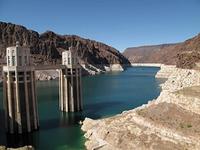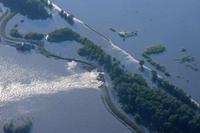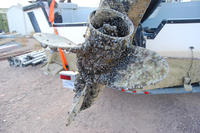-
Next-gen weather satellites to improve tornado warnings in South
More than a quarter of the 1,688 twisters confirmed across the United States in 2011 occurred in the four-state region of Alabama, Georgia, Mississippi, and Tennessee – and most of the 73 tornadoes hitting the United States in January 2012 occurred in those four states; southern tornadoes are especially insidious and challenging to track, and NASA’s weather satellites are now paying special attention to them
-
-
What U.S. can learn from EU chemicals law
U.S. industry and environmental groups agree that the Toxic Substances Control Act of 1976 needs to be modernized better to protect public health and the environment; there is no consensus, however, on what the reform should look like; researchers suggest that the United States may want to look at how the EU regulates chemicals
-
-
Asteroid 2011 AG5 worries to be justified – or not -- in February 2023
Asteroid 2011 AG5 is one of 8,744 near-Earth objects that have been discovered; it is approximately 460 feet (140 meters) in size; it is on a collision course with Earth for 5 February 2040 – but we will k now for sure in February of 2023, when it will pass Earth no closer than about one million miles, making it possible for scientists to plot its future trajectory
-
-
Future aircraft could capture, re-use some of their own power
When an Airbus 320 lands, a combination of its weight and speed gives it around three megawatts peak available power; researchers work on making the aircraft of tomorrow contribute to their power needs by harnessing energy from the wheel rotation of their landing gear to generate electricity
-
-
U.S. water shortages loom

More than 1 in 3 counties in the United States could face a “high” or “extreme” risk of water shortages due to climate change by the middle of the twenty-first century; 7 in 10 of the more than 3,100 U.S. counties could face “some” risk of shortages of fresh water for drinking, farming, and other uses
-
-
New app to help fight nonnative species invasion of U.S.
Nonnative species invading the United States — animals, pathogens, and plants — deplete water supplies, poison wildlife and livestock, and damage property in urban and rural areas at a cost of about $138 billion annually; the U.S. Forest Service funded the development of an iPhone application that helps people identify harmful, non-native plants
-
-
Fukushima accident caused only low levels of fallout in U.S.
Fallout from the 2011 Fukushima Dai-ichi nuclear power facility in Japan was measured in minimal amounts in precipitation in the United States in about 20 percent of 167 sites
-
-
2010 Russian heat wave caused by both manmade, natural causes
The heat wave that struck western Russia in summer 2010 killed 55,000 people and caused $15 billion in damage; a new study concludes that soaring temperatures were within the natural range for a Russian summer, but that due to human-induced climate change, the chance of such an extreme heat wave has tripled over the past several decades
-
-
Proposed EPA budget cuts funding from clean air and water grants
President Obama’s latest proposed budget for fiscal year 2013 cuts $105 million from the Environmental Protection Agency’s (EPA) budget, primarily from funds aimed at treating wastewater and drinking water
-
-
Local officials oppose “unacceptable” levee ratings

In recent years as part of an effort to bolster the nation’s flood protection infrastructure, the Army Corps of Engineers has analyzed and declared more than 200 levee systems across the country as “unacceptable,” resulting in a firestorm of criticism from local officials
-
-
Compressed natural gas as transportation fuel
A number of different fuel sources — ethanol, biodiesel, electricity, and hydrogen — have each shown their promise as an alternative to petroleum; scientists at Argonne Lab want to add one more contender to the list of possible energy sources for light-duty cars and trucks: compressed natural gas (CNG)
-
-
Invaders wreak havoc on U.S. ecosystems

In the decade since the 9/11 attacks, DHS’ focus on combatting terrorism has left some of its core agencies ill-equipped to perform its other missions, namely the Customs and Border Protection’s (CBP) ability to prevent invasive plants and insects from entering the United States and wreaking havoc on crops
-
-
Pepco buys solar competition prize-winning building for display
WaterShed, a prize-winning, energy-saving house designed by a team from the University of Maryland, has been bought by Pepco; the utility will maintain the building and open ot for public display
-
-
Europe crops damaged by pollution crossing oceans, continents
Pollution originating from North America is responsible for a 1.2 million ton annual loss of wheat in Europe; this is the biggest intercontinental ozone pollution-related impact on any food crop
-
-
Preparing for the end of the world as we know it
In a growing trend, more and more Americans across the United States are preparing themselves for a catastrophic apocalypse; for reasons ranging from terrorists to natural disasters or an economic meltdown, these individuals have begun stockpiling food, taking survival courses, or constructing safe rooms
-
- All
- Regional
- Water
- Biometrics
- Borders/Immig
- Business
- Cybersecurity
- Detection
- Disasters
- Government
- Infrastructure
- International
- Public health
- Public Safety
- Communication interoperabillity
- Emergency services
- Emergency medical services
- Fire
- First response
- IEDs
- Law Enforcement
- Law Enforcement Technology
- Military technology
- Nonlethal weapons
- Nuclear weapons
- Personal protection equipment
- Police
- Notification /alert systems
- Situational awareness
- Weapons systems
- Sci-Tech
- Sector Reports
- Surveillance
- Transportation
Advertising & Marketing: advertise@newswirepubs.com
Editorial: editor@newswirepubs.com
General: info@newswirepubs.com
2010-2011 © News Wire Publications, LLC News Wire Publications, LLC
220 Old Country Road | Suite 200 | Mineola | New York | 11501
Permissions and Policies
Editorial: editor@newswirepubs.com
General: info@newswirepubs.com
2010-2011 © News Wire Publications, LLC News Wire Publications, LLC
220 Old Country Road | Suite 200 | Mineola | New York | 11501
Permissions and Policies
